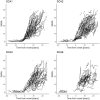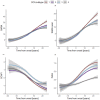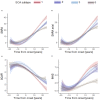Disease progression of spinocerebellar ataxia types 1, 2, 3 and 6 before and after ataxia onset
- PMID: 37592453
- PMCID: PMC10578893
- DOI: 10.1002/acn3.51875
Disease progression of spinocerebellar ataxia types 1, 2, 3 and 6 before and after ataxia onset
Abstract
Objective: Our aim was to study the evolution of ataxia and neurological symptoms before and after ataxia onset in the most common spinocerebellar ataxias (SCAs), SCA1, SCA2, SCA3 and SCA6. We therefore jointly analysed the data of the EUROSCA and RISCA studies, which recruited ataxic and non-ataxic mutation carriers.
Methods: We used mixed effect models to analyse the evolution of Scale for the Rating and Assessment of Ataxia (SARA) scores, SCA Functional Index (SCAFI) and Inventory of Non-Ataxia Signs (INAS) counts. We applied multivariable modelling to identify factors associated with SARA progression. In the time interval 5 years prior to and after ataxia onset, we calculated sensitivity to change ratios (SCS) of SARA, SCAFI and INAS.
Results: 2740 visits of 677 participants were analysed. All measures showed non-linear progression that was best fitted by linear mixed models with linear, quadratic and cubic time effects. R2 values indicating quality of the fit ranged from 0.70 to 0.97. CAG repeat was associated with faster progression in SCA1, SCA2 and SCA3, but not SCA6. 5 years prior to and after ataxia onset, SARA had the highest SCS of all measures with a mean of 1.21 (95% CI: 1.20, 1.21) in SCA1, 0.94 (0.93, 0.94) in SCA2 and 1.23 (1.22, 1.23) in SCA3.
Interpretation: Our data have important implications for the understanding of disease progression in SCA1, SCA2, SCA3 and SCA6 across the lifespan. Furthermore, our study provides information for the design of interventional trials, especially in pre-ataxic mutation carriers close to ataxia onset and patients in early disease stages.
© 2023 The Authors. Annals of Clinical and Translational Neurology published by Wiley Periodicals LLC on behalf of American Neurological Association.
Conflict of interest statement
None of the authors reports conflicts of interest regarding this manuscript.
Figures




References
-
- Jacobi H, Reetz K, du Montcel ST, et al. Biological and clinical characteristics of individuals at risk for spinocerebellar ataxia types 1, 2, 3, and 6 in the longitudinal RISCA study: analysis of baseline data. Lancet Neurol. 2013;12(7):650‐658. - PubMed
-
- Velazquez‐Perez L, Rodriguez‐Labrada R, Canales‐Ochoa N, et al. Progression of early features of spinocerebellar ataxia type 2 in individuals at risk: a longitudinal study. Lancet Neurol. 2014;13:482‐489. - PubMed
-
- Rezende TJR, de Paiva JLR, Martinez ARM, et al. Structural signature of SCA3: from presymptomatic to late disease stages. Ann Neurol. 2018;84:401‐408. - PubMed
MeSH terms
Substances
LinkOut - more resources
Full Text Sources
Research Materials

